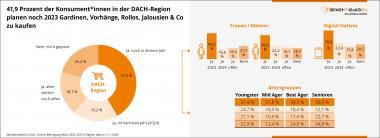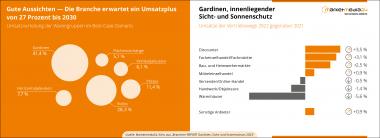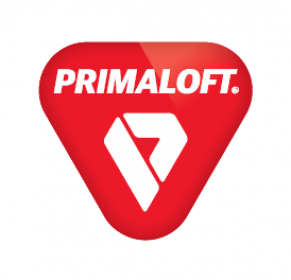Marketmedia24 veröffentlicht Studie zu Gardinen, innenliegender Sicht- und Sonnenschutz
- Umsatzplus von 27 Prozent bis zum Jahr 2030 möglich
Gardinen, innenliegender Sicht- und Sonnenschutz bilden einen Markt, der in Deutschland jährlich um rund 2 Prozent zulegt. Diese seit mehr als 15 Jahren geltende „Regel“ wurde 2020 mit einem Umsatzplus in Höhe von 5,3 Prozent durchbrochen. Der Corona-Schub fürs Zuhause hat auch die Nachfrage nach Verschönerungen und/oder Verhüllungen der Fenster beflügelt. Und wie in den meisten Living-Branchen flachte die Kauflust mit dem Rückgang der Pandemie ab. Zwar deutet der leichte Umsatzanstieg in 2022 die Normalisierung des Konsums an, doch das Mengenwachstum zog nicht im gleichen Maße an, so die Marktforscher von Marketmedia24, Köln, im aktuellen „Branchen-REPORT Gardinen, innenliegender Sicht- und Sonnenschutz 2023“. Gleichwohl gibt es positive Signale. So planen 41,9 Prozent der Konsument*innen in der DACH-Region noch in diesem Jahr neue Anschaffungen für ihre Fenster – und knapp 20 Prozent in 2024. Dies weisen die repräsentativen und zielgruppengenauen Forschungsergebnisse von 1.000 Personen aus, die Marketmedia24 exklusiv für die neue Studie befragt hat. Parallel geht das Best-Case-Szenario der Kölner Marktforscher davon aus, dass die Handelsumsätze mit Gardinen bzw. innenliegendem Sicht- und Sonnenschutz bis zum Jahr 2030 um 27 Prozent steigen werden.
Obwohl viele Deutsche auf ihr Budget achten müssen, bleiben die Produkte der Branche im Fokus der Menschen. So stellen Anbieter fest, dass aufgrund der gestiegenen Energiekosten gezielt nach Produktlösungen gesucht wird, die mit ihren isolierenden Eigenschaften beim Energiesparen helfen. Richtig eingesetzt können Hausbewohner auf lange Sicht bares Geld sparen und gleichzeitig zum Klimaschutz beitragen, unterstreicht der Verband innenliegender Sicht- und Sonnenschutz (ViS), Wuppertal, und verweist gleichzeitig auf das Zukunftspotenzial von „smarten Lösungen“. Diese tragen zur Verringerung des Energieverbrauchs im Sinne von Nachhaltigkeit und zur Gebäudesicherheit bei, gleichzeitig liegen in der Digitalisierung echte Wettbewerbschancen für die Fachbetriebe der Branche. Insgesamt gibt das Thema Nachhaltigkeit den Takt für die Zukunft von Gardinen, innenliegendem Sicht- und Sonnenschutz vor.
Dass das Thema in Teilen der Bevölkerung bereits ankommt, unterstreichen die aktuellen Primärforschungen von Marketmedia24. Danach ist es für 22,4 Prozent der Deutschen wichtig, dass Gardinen, Rollos, Jalousien & Co. nachhaltig produziert werden oder zertifizierte Umweltsiegel tragen. Für die überwiegende Mehrheit aller Befragungsteilnehmer*innen in der DACH-Region zählen jedoch Qualität, leichte Anbringungsmöglichkeit sowie das Produktdesign zu den wichtigsten Kaufkriterien.
Unter den Vertriebswegen sind aus Sicht der Gardinen-, Sicht- und Sonnenschutz-Hersteller der stationäre Fachhandel und Fachmärkte unverzichtbar. Zwar hat dieses Handelsformat als langjähriger Marktführer seinen Spitzenplatz an den Wettbewerb im Möbelhandel abgeben müssen. Aber mit dem Jahr 2022 wächst der Marktanteil der Spezialisten wieder leicht (plus 0,4 Prozentpunkte). Und gemeinsam mit dem Online-Handel sowie den Bau- und Heimwerkermärkten werden hier aktuell rund Dreiviertel der Marktumsätze repräsentiert.
Für die längerfristige Zukunft (bis 2030) bewertet Marketmedia24 die Entwicklung der Fachhandelsstufe tendenziell zurückhaltend. Dennoch weist das Best-Case-Szenario in der Studie aus, dass dieser Vertriebsweg innerhalb der nächsten sieben Jahre zulegen wird. Das Wachstum der Onliner und Versender wird mit plus 50 Prozent am stärksten ausfallen. Nicht ganz so rosig, aber auf jeden Fall positiv, können unter den gleichen Rahmenbedingungen auch Discounter, Bau- und Heimwerkermärkte und mit vergleichsweise leichterem Umsatzplus der Möbelhandel in die Zukunft schauen.
Wer aktuell und in Zukunft den Verbraucher*innen auf der Spur bleiben will, dem empfiehlt Marketmedia24 die beliebtesten Kommunikations- bzw. Informationsquellen zu studieren. So halten fast 70 Prozent der DACH-Bewohner*innen Suchmaschinen wie Google und Bing für „sehr wichtig“ bzw. „wichtig“, während Social-Media-Kanäle aktuell von 40,8 Prozent Zustimmung erfahren. Überraschenderweise sind für 56,5 Prozent der Youngster (bis 24 Jahre) Werbeprospekte wichtige Info-Tools, und noch einmal fast 50 Prozent dieser Zielgruppe sind an interaktivem Live Shopping zum Beispiel bei TikTok oder Instagram interessiert. Als noch wichtiger werden jedoch die Erfahrungen bzw. Empfehlungen von Freunden, Familie, Kolleg*innen und Kommiliton*innen bewertet.
Marketmedia24 Heimtextilien, Branchenanalyse, Marketmedia24 Gardinen, Sicht- und Sonnenschutz Heimtextilien Studie
Marketmedia24












